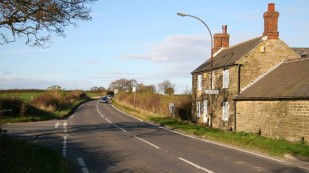When we think of UK oil and gas, we probably think first of the North Sea – but the origins of the UK’s oil industry are in some unexpected places….
Next week, our Petroleum Group and History of Geology Group are teaming up to hold a conference celebrating a number of anniversaries, including the centenary of the drilling of the first oil well in the UK – which took place in a small village in Derbyshire.
Hardstoft No. 1
In 1915, with war threatening supply lines, the UK Government recognised that it needed to be less dependent on imported oil. The search began for potential oilfields, eventually leading to Hardstoft in Derbyshire. Local colliaries had been reporting seepages of oil in the area, and the suitability of the geology, particularly the location of surface anticlines, made it a promising site to explore.
The work was carried out by American drillers, whose expertise and technology were far ahead of Britain. Since the equipment they used had been designated as strategic to the war effort, and could not be bought by foreigners, the drillers came too, living on site in unheated wooden houses.

Cheering the first appearance of oil at Hardstoft – image via http://www.illustratedfirstworldwar.com
On 27 May 1919, they finally struck oil, at 2070 feet. Production commenced in June, and an average of 6 barrels a day were produced for the next eight years – 2,500 tons of oil in total. Further exploration at the site also yielded some gas, which could be used to power the site and heat the workers’ houses.
There followed a complicated dispute over the ownership of the oil, eventually won by the owner of the land in which Hardstoft-1 was drilled, the Duke of Devonshire. He assumed control of the well in 1923 – becoming the UK’s first oil baron. Today, the Duke remains the only person in the UK to have the rights to the oil underneath his land.
Oil continued to be drilled at Hardstoft, but by 1927 the yield was so low that most of the oil was used directly by the Chatsworth estate to power a sawmill at Hardwick Hall.
When war struck again, the government found itself in similar difficulties over foreign imports, and the well was put back into production in 1938. It was finally closed in July 1945, and capped a few years later.

‘How oil is struck’ – image via http://www.illustratedfirstworldwar.com
Today, Hardstoft No. 1 still exists, and can be visited at a Garden Centre on the outskirts of the village of Tibshelf. A re-evaluation of the site, using well logs and seismic data acquired by BP, suggests that the field originally contained around 170,000 barrels, of which around 29,000 were produced.
- Read more about Hardstoft and the history of UK oil production in the upcoming March edition of Geoscientist magazine.
- The European Oil & Gas Industry History Conference is taking place at the Geological Society on 3-4 March.
Further Reading

